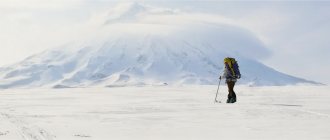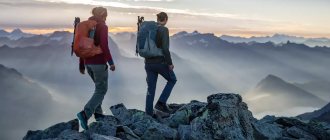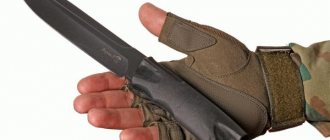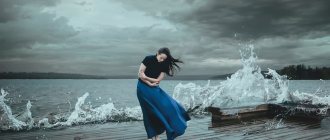Often, a novice tourist or a person who is going on a hike for the first time, even if it’s not a big one, finds it very difficult to navigate the questions: “What should you take on a hike?», «What to wear on a hike?», «How to pack a backpack correctly?" After all, it is very important to understand that you will have to carry everything yourself and each thing seems to weigh 100-300 grams, but in the end you gain extra pounds. A backpack weighing 15-20 kg or 20-25 kg is all a very big difference, both in weight and sensations stretched out over time. When you walk with a backpack, it seems that every hour the same 20 kg are getting heavier and heavier. And every time thoughts arise: what should have been left at home and what now definitely won’t be taken next time? Believe me, many people have such thoughts. And only professional tourists or tourists with very long experience have almost pre-prepared lists of their equipment, which change depending on the time of year and other conditions. And they know exactly how their clothes and equipment work. How it warms and protects from precipitation, and most importantly, how this equipment can be combined.
Our article is not for professionals , we will try to help just beginners, based on our personal experience and taking into account personal trial and error.
The success of any trip depends very much on planning. Unfortunately, without this boring part there is no way. And despite the fact that we are now going to talk about what to take with us and what to go with, or, more simply, camping equipment, then, in theory, we could provide a couple of ready-made lists for different occasions and that’s it. But without touching upon such a part as the general planning of the trip , it will not work.
Questions to ask yourself before going on a hike
In order to correctly select clothes, equipment and make a list of things for a hike , you must answer the following questions for yourself:
- Where am I going? Mountainous or forested areas, flat (or steppe, or desert). If mountainous, then what will be the maximum altitude that you will reach and at what maximum altitude you will spend the night. After all, in the mountains it is windy, the weather is often changeable, and with an increase in altitude the temperature drops (about every 100 meters of elevation gain by 0.6 degrees Celsius)
- How many days do I go? If the trip lasts 1-3 days, then you often don’t need to take a lot of spare things and most likely you won’t go far from the place where you started. And when going on a hike for 7-21 or more days, you should already understand that some of the basic things (on which your health and safety depend) must be duplicated: if things get wet, you need spare ones, until the main ones dry
- What time of year and what will the weather be like? It is clear that it will be impossible to predict the weather 100% (especially in the mountains), but you can still try to predict approximately the general trend. There must be protection from wind, rain and cold. And in the summer heat there should be protection from the heat (nobody needs sunstroke and sunburn). We are not taking on the topic of winter hiking now, since the equipment there is slightly different
- Where will I spend the night? Will it be shelters (houses), where you only need a mat and a sleeping bag, or will it be a tent—yours or your partner’s? If it’s a tent, then, returning to point number one, you need to understand the type of tent (lightweight, regular tourist, mountain). But let’s not delve into the choice of a tent for now; this is a separate topic; at this stage, it’s enough to think fundamentally about who will organize the overnight stay and how
- What will I eat and how (what will I cook with)? Everyone loves to eat good food, but no one likes to carry a heavy load. Therefore, the issue of food selection is very important. Here you need to maintain a balance between the weight/taste/nutrition of food. Again, this is a separate topic, but it’s also impossible not to think about it in advance. Plus, you need to think in advance whether you will cook over a fire, on burners, or whether there will be dry rations at all. How are things going with drinking water where you are going?
If you are not organizing your first hikes yourself, but are joining a group where there is a leader or a more experienced friend, then contact them for help in answering these questions. If the answers are not accurate (doubtful, or there are none at all), then this is a reason to think about the qualifications of such a leader and the possible unsafety of the trip.
Moving specifically to the list of equipment, it is also important to logically understand its structure, and here each person may have his own logic for arranging things into groups. Let's look at a couple of examples of how I formed my lists during my first independent hikes, and then a little later how these lists changed.
the formation of a list of “What to take on a hike” from at least two approaches: according to the principle of activity or situation (going/relaxing) and according to the principle of layers of clothing .
Let's start with the first one.
Important little things
1. passport
2. money
3. bank card
4. telephone
5. sunglasses - for my wife, I don’t use them myself.
6. map of the area - at least a printout, so that you can navigate the area and not have to put down your phone for this, which should also have a map loaded (3G internet may not work in some places) just in case.
7. needle, thread
8. *regular glasses, if you use them
As a supplement
9. Internet banking on a smartphone - it so happened that we had unexpected calls and the money on the phone ran out. What saved us was that we had Internet banking on our smartphone and we quickly topped up our account without having to go into town to do it.
List of things to pack for a hike by activity, situation or category
It seems to me that initially it is easiest to divide things into 2-3 large groups. For example:
- Running clothes (and any equipment or small items that may be useful while we are walking along the route). Here you will need to answer the questions for yourself: what will I wear most of the time on the hike, depending on the expected weather? And what will I wear if the weather conditions change: strong and cold wind, rain? What will help me while I walk? (For example, trekking poles make walking with a backpack over rough terrain much easier)
- Camp (bivouac). Equipment and clothing for camp and recreation. Here you can list the following sub-items:
- Sleeping equipment (tent, insulating mat, sleeping bag)
- Spare clothes (for long hikes)
- Sleepwear and camp wear (also leisure shoes)
- Insulation (head, top, bottom, legs) for evening/night/morning when the temperature drops
- Equipment for preparing and eating food (burner, gas, cooking utensils, dishes and utensils for eating, water containers)
- Safety and navigation (maps/compass, navigator, extra batteries, power bank, spare phone, flashlight, first aid kit, etc.)
- Personal hygiene
Let's consider, as an example, a list of equipment for an autonomous summer hike in Altai (excluding group equipment), for 14-16 days. In the list we will immediately provide explanations or justification for each position. The list is far from necessary to repeat and it is not ideal, someone can reduce it, someone can add to it, but with this example it is easier to explain the principles of selecting equipment for a hike. We consider it in this order: group, category, specific thing, why it is. At the end of each group there is a photo of an approximate view, so that it is easy to navigate.
Running clothes and equipment (useful little things on a hike):
- Top layer of running clothing
- The windbreaker is light, breathable (not a membrane, just like a windbreaker in cool weather, since insulating layers such as fleece jackets are blown by themselves)
- Synthetic breathable running pants – 1-2 pieces (main running pants, plus spare ones. Whether or not to take spare running pants is everyone’s business; some use membrane ones (more on them a little later) while the main ones are drying)
- Shorts (possibly an extra element, here everyone decides for themselves whether to carry an additional approximately 300 grams or not. Walking in shorts all the time in the summer can be pleasant, as long as you don’t walk through tall grass or bushes, which will scratch your feet, and your boots will and small plant debris, sand, and pebbles will get into your socks. But during the day, at rest stops in the heat, or on the road before the main hike, shorts can be very useful)
- Sun hat (protection from sunstroke and harmful ultraviolet radiation should be mandatory. Cap, Panama hat, wide-brimmed hat, whichever you prefer)
- A warm hat (preferably windproof. In cold weather (especially in the mountains), a hat may be needed not only in camp, but also on treks).
- “Fingerless” sports gloves (it’s convenient to walk in them with trekking poles, and when crossing ridges or rocks - to protect yourself with your hands)
- Buff (like a scarf and a light hat, or you can roll it up and cover just your ears from the wind, in general a universal thing)
- Gaiters/gaiters/flashlights (used when crossing snowy areas, muddy, and finely loose soils. They protect against small pebbles, sand and small vegetation getting into the boots)
- Protection from rain Membrane windbreaker-raincoat jacket (will protect against rain, and in case of strong cold winds you need to supplement it with a layer of insulation, such as a fleece jacket, vest, warm thermal underwear. Membrane fabrics themselves do not provide warmth)
- Membrane rain pants (protect from rain, wear in heavy downpour or prolonged rain for the whole day. Moreover, during heavy and unexpected rain, you can put them on directly over your walking pants, so that when the downpour passes, you can take them off just as quickly. Short rains are covered in ordinary synthetic pants, which dry quickly in the wind. An alternative to a membrane jacket and pants is a raincoat-poncho . Minus of a raincoat-poncho: the legs are not completely covered, plus: much cheaper than a set of membrane pants + jacket)
- Bottom layer of running clothing
- Thin, moisture-wicking thermal underwear (long-sleeved T-shirt + long johns) – 1 set + 1 T-shirt (one T-shirt with sleeves for 2 days, during which time the second one is washed and dried, and so on in a circle. Since synthetic clothing quickly absorbs unpleasant odors, and go With a backpack you won’t be able to avoid sweating. Cotton ones are not suitable because they get wet quickly and don’t release moisture and take a long time to dry.)
- Synthetic sleeveless T-shirt – 1-2 pieces (in warm and hot weather you can use them on transitions. The disadvantages of using them as the main running T-shirt are that the hands are not protected from sunburn and slight damage from branches and tall grass. The sun in the mountains is more active and creams do not always help in such cases, as they wear off physically or come off with sweat. Therefore, the basis for a mountain hike is long-sleeved T-shirts. Well, short-sleeved T-shirts can be used at rest stops and in the camp)
- Thin fleece jacket (made from materials like polartec 100, polartec micro, polartec powerstretch and other not very thick insulating jackets. During cold weather, when hiking under a windbreaker, you will sometimes need to wear insulation, and in the mountains at altitudes above 1500 m it is sometimes cold even in summer)
- Trekking boots (the main running shoes, chosen depending on the trail you are supposed to follow (or lack thereof), the time of year, and the weight of the backpack. Even excluding heavy mountain and mountaineering boots, there can be three options. Trekking sneakers (or low trekking boots), hiking boots and standard trekking boots. We will tell you in detail about choosing shoes for hiking a little later, but in short, if you are choosing your first hiking shoes, it is still better to choose medium classic trekking boots (not lightweight - hiking and NOT low in height To have ankle support, a durable sole, fewer seams. This will be the most universal option)
- Trekking socks NOT insulated - 2-4 pairs (2 or 4 pairs - this depends on whether you wear trekking boots, under the basic thick trekking socks, wear additional thin, so-called liners. Almost any trekking shoes are quite rigid and will rub your feet in almost 100% of cases when using regular cotton socks or just thin synthetic ones. Trekking socks have special thickenings either in certain places or over the entire area, which play a shock-absorbing role and save from chafing and calluses. At the same time, despite for their thickness, they use special threads (for example coolmax), which remove moisture rather than heat, and you will not be very hot)
- Insulated trekking socks – 2 pairs (useful during treks on cold days or if you plan to cover snowy areas for a long time, and will also be useful in the camp in the evenings)
- Trekking poles (they greatly facilitate and speed up moving with a backpack both over rough terrain and along good trails. They help distribute the weight, removing excess load from the legs, plus they serve as insurance. By the way, when crossing fords, self-insurance also helps a lot, so and additional insurance for your comrades. A mandatory accessory on a hike)
- Backpack + rain cover for a backpack (raincover/raincover) (the choice of a backpack is a separate and large topic, but briefly we can say that a lot depends on the convenience of the backpack, almost the same as the comfort of shoes. Or your hike will turn into hellish test, or you will be surprised to notice that despite the weight and number of things, it is quite normal for you to walk, and perhaps even walk easily. And you will spend the saved energy on contemplating the nature around. This is why we go hiking. Convenience is affected volume of the backpack, quality and design of the suspension system (back, belt, straps), number of settings for your back, overall quality of materials and weight of the backpack. But weight comes last, the main thing is that it is comfortable for you)
- Bottle/flask/container for operational drinking - 0.5 l (operational container for water. This can be a regular 0.5 l plastic bottle for water, it can be a drinking system (camel bag) or various special tourist flasks for water)
Camp:
- A warm/thick fleece jacket or a down sweater (in the evenings in the camp, especially in mountainous areas, it is quite cold, even in summer the temperature can approach zero, so in addition to a thin fleece jacket, you need to have a warm one made from materials, for example, Polartec Thermal Pro, Polatec High Loft; either a down sweater or instead of down - synthetic insulation like Primaloft, Climashield)
- Insulated thermal underpants (made from a material like Polartec PowerStretch or wool. May be needed in the evening at camp on cold evenings, plus on cold nights, if your sleeping bag is not warm enough, you can sleep in them)
- Thermal underwear (a T-shirt with sleeves) of a loose fit or a cotton T-shirt with long sleeves (for relaxing in the camp and sleeping. You should always have a dry set, what you will change into when you arrive at the campsite and take off your backpack)
- Wool socks for sleeping (warm trekking socks are not suitable for sleeping, as they are compression and will not allow your feet to rest. Therefore, ordinary woolen knitted socks are what you need)
- Lightweight insulated gloves (made from a material like Polartec PowerStretch. In the evening, even in summer, it can be cool, and if you take photos or videos, then gloves are required, since during the operating hours (for photographers, the operating time is 30-40 minutes before and after dawn and 30-40 minutes before and after sunset) the temperature even in summer in the mountains can be about 0..+5)
- Cotton socks – 2 pairs (it will be convenient to wear them at camp to rest your feet, for example, under a regular woolen sock)
- Sneakers/sandals (replacement shoes for camp and for crossing fords. Instead of sneakers, you can use sandals with non-slip soles and a protected toe. As a last resort - ordinary slates, but then you will have to ford rivers in boots, and use slates only in parking lots and in the camp .Rivers and streams should not be crossed, since in this case the leg is not fixed and there is a high probability of injury, which is unacceptable.There are two approaches to the fords.Someone crosses them in basic trekking boots, naturally, after that they get completely wet. The argument for this position is that on a multi-day hike, the boots are still slightly damp from sweat, dew, small streams and the fact that they will be completely wet for some time makes no difference, but with intensive walking they semi-dry from a wet state again.The second approach is this have closed or protected sandals with a secure fit or sneakers with strong soles, synthetic uppers, quick-drying, and ford rivers in them. Personally, I prefer the second option, since it is still more pleasant to walk in more or less dry trekking boots. And if they have a membrane, then if they get completely wet, they will dry even longer than without a membrane. And constantly damp and wet feet are also an accelerated path to chafing and calluses)
- Swimming trunks/swimsuit (depending on what area your hike is in)
- Underwear (briefs+spare)
- Sleeping bag (Comfort temperature +3, Comfort temperature limit -2, Extreme temperature -14) (on a multi-day hike, it is better to take a sleeping bag with a synthetic filler than a down one. On a multi-day hike, there is a chance that the sleeping bag will pick up moisture (during sleep, the body secretes up to 100 ml of sweat), and down in such conditions stops warming, falls off and requires complete drying. Synthetics do not have these disadvantages, but with the same thermal capacity as a down sleeping bag, they are bulkier and heavier. Synthetic sleeping bags are cheaper than down sleeping bags. In general, down sleeping bags are recommended mainly for mountaineering, short winter hikes, for professionals who clearly understand how to handle it, or for extremely low temperatures. Almost all sleeping bags have a temperature range of use: comfort temperature, comfort temperature limit, extreme. In order not to make a mistake, be guided on the comfort temperature (T-comf), and not on the comfort temperature limit (T-lim), and having already spent a little time with such a sleeping bag and having tested it below the comfort temperature, you can draw personal conclusions. No one has ever died from heat, but hypothermia is critical. Therefore, if you know that you are colder than people around you at the same temperature, then still choose a warmer sleeping bag than everyone else. Only you know yourself)
- Thermal insulation mat (foam mat, self-inflatable mat, inflatable mat. The choice depends on the expected temperature at night, budget and desired level of comfort. But thermal insulation comes first, that is, we focus on the night temperature)
- Tent (the choice of tent again depends on the time of year, the altitude of the hike and the number of people per tent. This is the topic of a separate article. In general terms, usually for initial tourism a two-person, two-layer tent (with a separate awning without a skirt) of a dome-shaped design and an aluminum frame is enough )
- Seat/pendal, butt support (almost a mandatory accessory, wherever you sit, you will be warm, dry (well, except in a puddle!) and a bonus - clean pants at the butt)
- Compact microfiber towel (a microfiber compact towel weighing about 50 grams is much lighter and more compact than a standard cotton towel, plus it dries much faster)
- Personal hygiene kit (soap, compact washcloth, wet wipes and wet toilet paper, regular toilet paper)
- Insect repellent or mosquito net for a cap (if you go above the forest zone in the highlands, then such things are not needed, but in the forest zone mosquitoes can ruin any evening)
- Camera + spare batteries (optional, this is additional weight and considerable, so it all depends on the purpose of the trip)
- Mug, Spoon, Bowl, Penknife, Fork (in equipment lists you can often find the abbreviation KLMN (mug, spoon, bowl, knife). You can also add a fork here, sometimes it is combined with a spoon. The heaviest options are steel utensils, lighter - aluminum, even lighter - plastic or titanium (but titanium is the most expensive). Same with a cup and bowl: metal - reliable and can, in extreme cases, be heated over a fire; plastic - easy, but you can’t heat anything in them; titanium - easy , but expensive)
- Burner (gas or multi-fuel) + saucepan (container for cooking or heating food on the burner)
- Gas (liquid fuel) for burner
- Waterskin (A container into which you will collect water from a source or carry a supply of water over a distance if there is no water in the place where you plan to stand. If you don’t have a waterskin, and some models are very expensive, then simple plastic two-liter bottles will help out)
- Matches, lighter, flint (in a moisture-proof bag)
- Garbage bags (we all want to walk along a clean path and come to a clean clearing with green grass, but for this to happen, we need to take all the garbage with us and then throw it into a container, from where garbage is regularly taken out. And for this you need to take bags with you for garbage and preferably stronger)
- Headlamp + spare batteries (classified in the safety section, since if twilight and night find you on the move, then this is an emergency situation and then the headlamp can already be classified as a safety element. Well, in the camp it is an element of everyday life and comfort)
- Tourist navigator + spare batteries (on light and short routes, instead of a separate tourist navigator, you can use a smartphone with navigation software (for example, maps.me or others). A separate tourist navigator has such advantages as: high protection from weather conditions and other influences (certain shockproof and waterproof), longer operating time (plus you can use ordinary replaceable elements that you can take with a spare), more compact sizes, higher accuracy, in models with buttons - the ability to work in the cold and with gloves (not a touch screen), well and most importantly, your safety is higher, since the smartphone is not used as the main navigator and does not run out of charge and always remains just a means of communication or a spare navigation device. Cons: high price for a device that is not used most of the time in a regular “off-the-road” life)
- Compass + map (should be an addition to electronic navigation, since in addition to the fact that the batteries may simply run out, you may forget spare ones or have some other problem with the batteries. In general, any electronic, even secure device, may someday fail. Therefore there must be a backup plan. It is advisable to familiarize yourself with a paper map of the area in advance and understand which paths or sections you will follow, how it all relates to the cardinal directions, what are the main landmarks)
- First aid kit (in addition to individual medications for the treatment of any of your specific diseases, there should be a standard set of remedies for most situations. The further you go and the more autonomous your hike, the more you need to think through your first aid kit. Even for one-day hikes, it is advisable to take at least a set of plasters)
- Sunscreen (in the mountains the sun is much more active, and in the middle zone it can also be very hot during the day. Sunburns do not add health to anyone. And on top of everything else, mechanical abrasions occur faster on burnt skin, plus exposure to sweat and dust - all this can lead to to not very pleasant consequences)
- Sunglasses (eye protection is a rather important point. If in the middle zone it’s just your comfort from an excessively high level of lighting, then in the mountains the sun is much more active, the level of ultraviolet radiation is higher, so sunglasses are simply a must. And if you know that the hike will be mountainous , then it is advisable to select glasses with a higher level of radiation protection).
- Phone + powerbank (a powerbank battery will be useful for smartphone users; you can additionally take a push-button phone for emergencies - it holds a charge longer)
- Waterproof case for documents and money (passport, money, basic contact information on paper should be reliably protected)
- A hermetic bag for a sleeping bag and a spare set of clothes (a modern backpack made of synthetic materials is lightweight; it can easily withstand short-term rain; a cape on the backpack (raincover) should protect from longer rain. But if there is a long rain shower or a fall into the water, then a certain set of equipment should always remain dry. This is a sleeping bag and a couple of spare things (a T-shirt with sleeves, underpants, spare socks), in which you will change clothes and climb into this sleeping bag to warm up)
- Rescue thermal “blanket” (will not take up much space or weight, but may come in handy)
- Nail scissors (in a secure package so as not to tear anything. In two weeks, your nails will grow back quite a lot, and an unsuccessfully broken nail is already a matter of health and even safety. And overgrown and long toenails will make holes in your socks, and worse , so you can even tear the membrane layer in the boot (in very advanced cases)
- Needle and thread (such a repair kit is advisable on a long hike; sometimes sewing clothes at the right time will preserve them until the end of the hike)
- Scotch tape (whether it’s needed or not, everyone decides for themselves. But sometimes something needs to be tightly wrapped, repaired, or sealed)
List of things to pack for a hike based on layers
Another approach to packing for a backpacking trip is to create a list of gear based on layers . In modern equipment there is such a principle, its essence is that more layers with different characteristics and different levels of insulation are better, and fewer layers are worse , for example, so that the top layer combines both insulation and protection from moisture. Instead of a set of thin thermal underwear plus a membrane jacket with permanent insulation, it is better to take the same thermal underwear, plus a separate thick fleece jacket, plus a separate membrane jacket. So that you have the opportunity to combine layers. The classic scheme is three layers.
- The bottom layer (first) is the base layer, its task is moisture removal, sun protection or light insulation (if the thermal underwear is insulated)
- The middle layer (second) is an insulating layer, it can be a fleece jacket, a down vest (or made of synthetic insulation), an insulating vest
- The top layer (third) is protection from precipitation (rain, wind) and mechanical protection (branches, bushes), these are various types of jackets and pants
You can group clothes according to these principles, but then you must already mentally imagine that in the same group there can be clothes for different situations, despite the fact that they belong to the same layer.
I also advise you not to be lazy and weigh all your equipment (every item) on scales (which show weight down to grams, for example an electronic kitchen scale 5-5000 grams) and enter all this information into a spreadsheet. Then, when compiling a list, you will immediately see the final weight. Of course, on your first hikes, these numbers won’t tell you anything, but as you gain experience, you will have a clear understanding of how you perceive a difference of 3-5 kg during long walking.
Let's give an example of a list of equipment that I used for a four-day hike in the Southern Urals, in the Iremel Natural Park, with an ascent to Mount Big Iremel (absolute height 1582 m above sea level). Overnight stays were planned on a plateau with an absolute height of 1330 m . It was assumed that the temperature would decrease by 5-10 degrees Celsius relative to the settlement, which is located at an absolute altitude of 550 m. The time of year is the end of July. The forecasted weather in the village (Tyulyuk village) at night is about 15 degrees Celsius. (the brands described in the table are not advertising, not recommendations, but simply what was available, maybe someone will be interested):
In total, the weight of all my equipment for this trip, excluding what I’m wearing (items with weight = 0) is 14.7 kg. It seems to me that this is quite a lot. And this is without food. But I also assumed possible precipitation (which, by the way, there was, and the membrane clothing came in handy, as well as the trekking membrane boots, in which I actually kneaded the mud in places on the trails) and a possible cold snap at night. By the way, there was no cold weather and therefore a warm fleece jacket, insulated long johns, and warm trekking socks were not useful to me, but I was ready and calm, since weather changes in the mountains are a common occurrence.
Drawing up such a table with weight, firstly, will show you the weight of each thing, and it will be possible to analyze whether it is possible to find similar things with less weight? You will see the strengths and weaknesses of your equipment. Secondly, when all your equipment is weighed and recorded, it is easy for you to choose from such a list, include or exclude some things, and immediately see the result of how much it will weigh in the end.
Some of the gear on this list weighs more than I'd like, so I could lose about 4 more pounds on this list alone. As we can see, the “Other Equipment” has the heaviest weight – almost 11.5 kg. And it contains the heaviest things: tent , sleeping bag , backpack , camera and tripod - 8.6 kg. And if you do not take into account photographic equipment, then the weight of the tent , backpack and sleeping bag is 6.3 kg. If photographic equipment is optional and optional, then a two-person tent weighing 2.85 kg for one person is clearly overkill. A backpack can also be found lighter, but backpacks with a less comfortable and functional “back” and a suspension adjustment system (belt, straps) will be lighter. Here you already have to think about whether to reduce the weight of the backpack itself, sacrificing comfort or even health? If you don’t have a completely healthy back, perhaps an uncomfortable backpack (just for you), even one that’s lighter by one or more kilograms, will ruin your whole hike, as your back will hurt, you’ll get tired earlier and, as a result, the enjoyment of the hike will be significantly less (and also more harmful to health). Well, there are also sleeping bags that are lighter and with the same temperature ranges, but, however, they are more expensive.
"Big Three". Tent, Backpack, Sleeping bag. The heaviest items in your hiking gear
It was not for nothing that we focused attention on three positions - a tent , a backpack and a sleeping bag . As we see in the example above, they usually have the greatest weight, both individually and together. In the tourist environment, especially in “light travel” (one of the areas in tourism where people try to reduce weight as much as possible, but only so that it does not threaten safety), these three positions are called the “Big Three” .
Backpack
As mentioned above, saving on the weight of the backpack must be justified; choosing a light backpack can only be done when it is convenient for you. Therefore, when choosing a backpack, the main thing is:
- Convenience. That is, how it sits on you loaded approximately to real travel values
- Volume. The capacity of the backpack should be adequate for the trip. Everything you want to take must fit in it. On average, a 75-95 liter backpack should be enough (someone may need a 90-110 liter backpack - it all depends on your tasks). If it’s more, it’s not scary, it’ll just be heavier and will need to be pulled down (however, let us remind you that excess weight does not bring joy on a hike)
- And only in third place is weight . Despite the fact that we want to save weight, if the first two points are incorrect, that is, the backpack is not comfortable and everything you need will not fit into it, then the trip will be ruined and unsafe. Your back will hurt, and hanging a lot of equipment outside is also inconvenient and unsafe. Of course, weight is important, but after the first two points.
Sleeping bag
with a sleeping bag either. In the sense that you sleep in it, take a break from the day's work. Your next day, and the next, and so on for the entire trip, depends on how well you sleep. And your safety also depends on this: you should not allow hypothermia during sleep, this can lead to illness, and critical hypothermia can lead to death. Sometimes, of course, you can sleep dressed in a medium insulating layer or completely dressed, this will compensate for the lack of insulation of the sleeping bag. But a novice tourist should not take such cases as the norm, because you may not guess (but experienced tourists know their sleeping bags, their body, and how they can additionally insulate themselves for sleep from the clothes and equipment they have with them).
Tent
A tent is a little easier. It is logical that it is advisable to select a tent according to the number of participants in the trip. Of course, having 3-4 or even more tents is not cheap (and let’s face it, it’s very expensive). Therefore, there are often compromises. As in our example, a two-person tent is sometimes used for one person. Yes, it's overweight. But, for example, I don’t currently have a single-person tent, and the cost of such a tent is high (literally only 15-20% cheaper than the same model, but a double one and its weight is not 2 times less than a double one, but usually by 25-35%) and it makes sense to buy it if solo trips happen often. Well, the tent must be adequate to the conditions of the hike: you cannot take an ultra-light tent made of thin materials on a high-mountain or winter hike.
Dishes
When choosing the necessary set of dishes for a hike, it all depends on how much the cult of food is taught in your group. But the basic minimum for long trips looks like this: several pots with lids (can be divided among the participants of the trip), a mug, a thermos, a ladle, a potholder for frying pans - a handle, a spoon, a knife (each has their own). As experience suggests, the best material for camping utensils is titanium. Among the more budget-friendly options, you can pay attention to stainless steel.
Mistakes made by novice tourists when preparing equipment for a hike
- Took too much . The first and most common mistake is going overboard with the weight of the equipment. They either took unnecessary things that were not adequate for the hike (heavy books, teapots, heavy axes, a lot of electronics). Or he took a lot of everyday clothes instead of camping equipment (for example, jeans instead of synthetic hiking pants). Yes, travel clothing is not cheap. But there are inexpensive brands of domestic manufacturers, plus there are large chain sports stores that have equipment for beginners, but still suitable for the conditions of a hike, not a city.
- Getting ready on the last day before departure leads to mistake No. 1 and to the fact that we generally forget to take something important, sometimes something very important.
- Take too little and get cold, wet, etc. The opposite of the first point. Often the problem comes from point No. 2 and the unwillingness to think through the conditions of the trip in advance.
- Don't know your equipment . Don’t know how the equipment works: it warms, protects from rain, how much it weighs, how much it folds, how much gas the burner consumes and how reliable it is, etc. It is advisable to check everything in advance in the city, at home, during training (jogging), and walks.
- Do not wear your shoes in , do not guess the size of your shoes. I got caught doing this myself and it was very unpleasant. With the first boots I didn’t guess the width of the last, after a couple of small hikes I had to sell them cheap. With the second ones, I didn’t distribute them in advance. It seemed that they were comfortable right when trying them on and advice on wearing them was not about them, and so it will go. It didn't work. On the third day of the hike, problems began that lasted for two weeks. They were heard just during the same two weeks during the hike (distracting from everything around). And on my next hike, I was only surprised - how comfortable my boots were, but how uncomfortable was it for me in them in Altai? But along with the beauty of the Altai lakes, I still remember the bruises in the Achilles tendon area.
- Be lenient with navigation and your positioning . Simply put, do not take a map or compass with you and go only with a phone (as a navigator) or without it at all. With the hope that the paths are obvious, marked, and “so why wander around there, because everything is simple and not far away.” This is how people get lost.
Clothes and shoes
When an experienced traveler is asked what clothes to choose for a hike, in 99% of cases he will answer, “Comfortable!”
And this statement is confirmed by centuries of amateur and professional experience. It is worth remembering that choosing clothes for a multi-day hike is akin to an art - long trips do not forgive mistakes, so you should approach the issue as responsibly as possible. The main principle of choosing clothes for a hike is gradation. It implies that if there is a noticeable change in temperature throughout the expedition, you can painlessly and quickly reduce or, on the contrary, increase the temperature by removing or, on the contrary, adding items of clothing accordingly. There is a so-called three-layer concept of clothing, which implies the presence of: “second skin” or thermal underwear, a layer of “insulation” - soft and warm clothing made of fleece or down, as well as a layer of protection in the form of wind-repellent clothing. It is important to remember that each of the layers is important in its own way and should not be underestimated when choosing.
Choosing shoes is a very individual thing, but to ease the pain of choosing, consider the following points: the type of terrain you will be walking on (rocky surface, dangerous slopes, etc.), wet ground and grass, mud, snow, ice and cold. The choice of trekking boots will depend on the type of coating and the ambient temperature: lightweight, universal or boots for complex trekking.
What not to take with you on a hike
- Ordinary heavy and breakable household dishes.
- Excessive amount of electronics (laptops, tablets, players, etc.). By the way, you are also unlikely to get around to reading the book due to the lack of extra time and the presence of new impressions.
- A large amount of cotton clothing (gets wet quickly, becomes heavy, takes a long time to dry). This also includes jeans and canvas fabric.
- City shoes. It will quickly fail, unsafe, uncomfortable.
- Excessive amount of food (obviously excessive).
- Everything is camouflage. If the purpose of your trip is not hunting/fishing/photo-hunting, then from the point of view of passive safety you should choose clothes of bright colors, so they will find you faster if you are lost.
- Heavy axes, saws (after all, the lighter the backpack, the more fun the hike! Therefore, if we take it, it’s the lightest ax possible).
- Camping furniture (chairs, table). No matter how light they are, it is better to leave them for their intended purpose, namely camping. When you don't have to carry them on yourself.
Well, the main thing you should definitely take with you on a hike is a good mood!
Author of the article: Mikhail Adonin











